Table of Contents
Paheli and Boojho went on vacation to many places of interest. One such trip took them to the river Ganga in Rishikesh. They climbed the mountains of the Himalayas, where it was very cold. They saw many kinds of trees on these mountains — oaks, pines and deodars, very different from the ones near their home on the plains! In yet another trip, they travelled to Rajasthan and moved on camels through the hot desert. They collected different kinds of cactus plants from this trip. Finally, they went on a trip to Puri and visited the sea beach, dotted with casuarina trees. While recollecting all the fun that they had on these trips, a thought struck them. All these places were so different from one another, some were cold, some very hot and dry, and some places so humid. And yet all of them had many organisms (living creatures) of various kinds.
They tried to think of a place on Earth where there may not be any living creatures. Boojho thought of places near his home. Inside the house, he tried the cupboards. He had thought that there may not be any living organisms here, but he found one tiny spider in the cupboard. Outside the home too, there did not seem to be any place, he could think of, that did not have living creatures of some kind or the other (Fig. 9.1). Paheli started thinking and reading about far away places. She read that people have even found tiny living organisms in the openings of volcanoes!
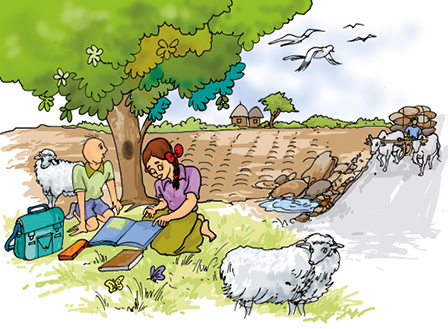
Fig. 9.1 Search for living organisms
9.1 Organisms and the Surroundings Where They Live
Another thought that occurred to Paheli and Boojho was about the kinds of living organisms that were present in different locations that they had visited. The deserts had camels, the mountains had goats and yak. Puri had some other creatures — crabs on the beach and such a variety of fish being caught by the fishermen at the sea! And then, there did seem to be some creatures like ants that were present in all these different locations. The kinds of plants found in each of these regions were so different from the plants of the other regions. What about the surroundings in these different regions? Were they the same?
Activity 1
Let us start with a forest. Think of all the plants, animals and objects that can be found there. List them in Column 1 of Table 9.1. List things, animals and plants, found in the other regions that are also shown in the table. You can collect the examples scattered through this chapter to fill Table 9.1. Discuss also with your friends, parents and teachers, to find more examples to fill the tables. You can also consult many interesting books in libraries that talk of animals, plants and minerals of different regions.
Try and include many plants, animals and objects, big and small, in each of the columns in this table. What kind of objects will we find that may not be animals or plants? Perhaps parts of plants like dried leaves, or parts of animals, like bones. We may also find different kinds of soils and pebbles. Water in the oceans may have salts dissolved in it as discussed in Chapter 5. There could be many more objects.
As we go through the chapter, keep adding more examples to Table 9.1. We will discuss the table as we travel through many more interesting places.
Table 9.1 Animals, plants and other objects found in different surroundings

9.2 Habitat and Adaptation
What do you find from the plants and animals listed in Activity 1? Did you find a large variety in them? Look at what you have entered in the column for the desert and the column for the sea in Table 9.1. Did you list very different kind of organisms in these two columns?
What are the surroundings like, in these two regions?
In the sea, plants and animals are surrounded by saline (salty) water. Most of them use the air dissolved in water.
There is very little water available in the desert. It is very hot in the day time and very cold at night in the desert. The animals and plants of the desert live on the desert soil and breathe air from the surroundings.
The sea and the desert are very different surroundings and we find very different kind of plants and animals in these two regions, isn’t it? Let us look at two very different kind of organisms from the desert and the sea – a camel and a fish. The body structure of a camel helps it to survive in desert conditions. Camels have long legs which help to keep their bodies away from the heat of the sand (Fig. 9.2). They excrete small amount of urine, their dung is dry and they do not sweat. Since camels lose very little water from their bodies, they can live for many days without water.
Let us look at different kinds of fish. Some of these are shown in Fig. 9.3. There are so many kinds of fish, but, do you see that they all have something common about their shape? All the ones shown here have the streamlined shape that was discussed in Chapter 8. This shape helps them move inside water. Fish have slippery scales on their bodies. These scales protect the fish and also help in easy movement through water. We discussed in Chapter 8, that fish have flat fins and tails that help them to change directions and keep their body balance in water. Gills present in the fish help them to use oxygen dissolved in water.
We see that the features of a fish help it to live inside water and the features of a camel help it to survive in a desert.

Fig. 9.2 Camels in their surroundings
We have taken only two examples from a very wide variety of animals and plants that live on the Earth. In all this variety of organisms, we will find that they have certain features that help them live in the surroundings in which they are normally found. The presence of specific features or certain habits, which enable an organism to live naturally in a place is called adaptation. Adaptation of organisms differ depending on their place of dwelling. That is why a fish cannot live out of water and a camel cannot live in sea.
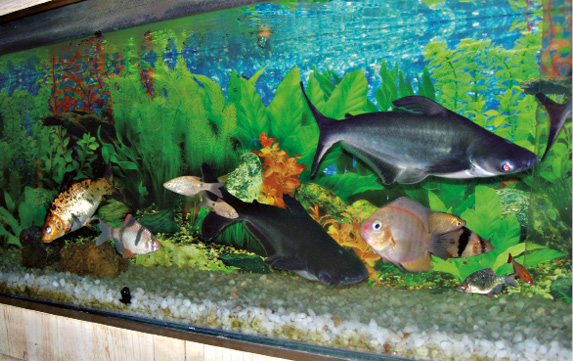
Fig. 9.3 Different kinds of fish
The place where organisms live is called habitat. Habitat means a dwelling place (a home). The habitat provides food, water, air, shelter and other needs to organisms. Several kinds of plants and animals live in the same habitat.
The plants and animals that live on land are said to live in terrestrial habitats. Some examples of terrestrial habitats are forests, grasslands, deserts, coastal and mountain regions. On the other hand, the habitats of plants and animals that live in water are called aquatic habitats. Lakes, rivers and oceans are some examples of aquatic habitats. There are large variations among terrestrial habitats like forests, grasslands, deserts, coastal and mountain regions located in different parts of the world.
There are some changes that can happen in an organism over a short period of time to help them adjust to some changes in their surroundings. For instance, if we live in the plains and suddenly go to high mountain regions, we may experience difficulty in breathing and doing physical exercise for some days. We need to breathe faster when we are on high mountains. After some days, our body adjusts to the changed conditions on the high mountain. Such small changes that take place in the body of a single organism over short periods, to overcome small problems due to changes in the surroundings, are called acclimatisation. These changes are different from the adaptations that take place over thousands of years.
The organisms, both plants and animals, living in a habitat are its biotic components. The non-living things such as rocks, soil, air and water in the habitat constitute its abiotic components. Are sunlight and heat biotic or abiotic components?
We know that some plants grow from seeds. Let us look at some abiotic factors and their effect on seeds as they grow into young plants.
Activity 2
Recall Activity 5 in Chapter 1 — we made sprouts from moong and chana seeds. When the seed turned into a sprout, it is said to have germinated. This is the beginning of life of a new plant.
Collect some dry moong seeds. Keep 20-30 seeds aside and soak the rest in water for a day. Divide the soaked seeds into four parts. Keep one part completely submerged in water for 3-4 days. Do not disturb the dry seeds and those submerged in water. Keep one part of soaked seeds in a sunny room and another in a completely dark region like a cupboard that does not allow any light to come in. Keep the last part in very cold surroundings, say, in a refrigerator or with ice around them. Rinse them and replace the water every day. What do you notice, after a few days? Do the seeds in all the five conditions germinate uniformly? Do you find slower or no germination in any of these?
Do you realise that abiotic factors like air, water, light and heat are important for the growth of plants. In fact, abiotic factors are important for all living organisms.
We find that organisms exist in very cold as well as very hot climates, isn’t it? How do they manage to survive? Adaptation is the method by which organisms get well adjusted to the climate.
Adaptation does not take place in a short time because the abiotic factors of a region also change very slowly. Those organisms which cannot adapt to these changes die, and only the adapted ones survive. Organisms adapt to different abiotic factors in different ways. This results in a wide variety of organisms in different habitats.
Let us look at some habitats, understood the abiotic factors and the adaptations of animals in these habitats.
9.3 A Journey Through Different Habitats
Some Terrestrial Habitats
Deserts
We discussed the abiotic factors of a desert and the adaptations in camels. What about other animals and plants that are found in deserts? Do they have the same kind of adaptations?
There are desert animals like rats and snakes, which do not have long legs that a camel has. To stay away from the intense heat during the day, they stay in burrows deep in the sand (Fig 9.4). These animals come out only during the night, when it is cooler.
Fig. 9.5 shows some typical plants that grow in a desert. How are these adapted to the desert?
Activity 3
Bring a potted cactus and a leafy plant to the classroom. Tie polythene bags to some parts of the two plants, as was done for Activity 4 in Chapter 7, where we studied transpiration in plants.
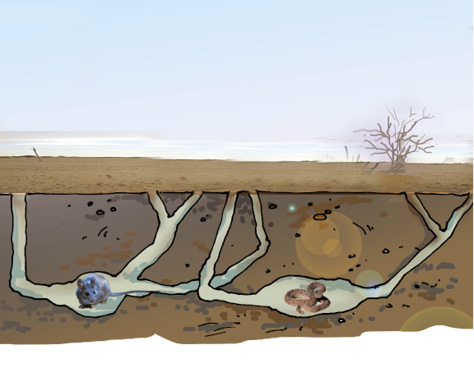
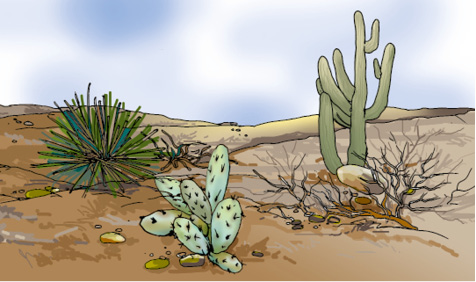
Fig. 9.5 Some typical plants that grow in desert
Leave the potted plants in the sun and observe after a few hours. What do you see? Do you notice any difference in the amount of water collected in the two polythene bags?
Desert plants lose very little water through transpiration. The leaves in desert plants are either absent, very small, or they are in the form of spines. This helps in reducing loss of water from the leaves through transpiration. The leaf-like structure you see in a cactus is, in fact, its stem (Fig. 9.5). Photosynthesis in these plants is usually carried out by the stems. The stem is also covered with a thick waxy layer, which helps to retain water in the tissues of cacti. Most desert plants have roots that go very deep into the soil for absorbing water.
Mountain regions
These habitats are normally very cold and windy. In some areas, snowfall may take place in winters.
There is a large variety of plants and animals living in the mountain regions. Have you seen the kind of trees shown in Fig. 9.6?
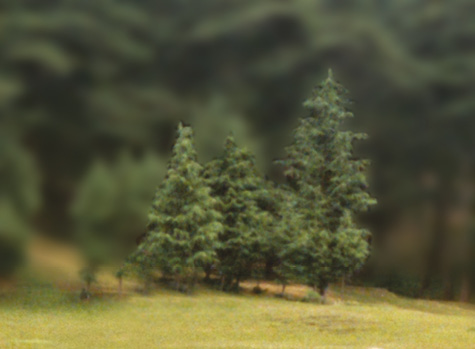
Fig. 9.6 Trees of a mountain habitat
If you live in a mountain region or have visited one, you may have seen a large number of such trees. But, have you ever noticed such trees naturally growing in other regions?
How are these trees adapted to the conditions prevailing in their habitat? These trees are normally cone shaped and have sloping branches. The leaves of some of these trees are needle-like. This helps the rainwater and snow to slide off easily. There could be trees with shapes very different from these that are also present on mountains. They may have different kind of adaptations to survive on the mountains.
Animals living in the mountain regions are also adapted to the conditions there (Fig. 9.7). They have thick skin or fur to protect them from cold. For example, yaks have long hair to keep them warm. Snow leopard has thick fur on its body including feet and toes. This protects its feet from the cold when it walks on the snow. The mountain goat has strong hooves for running up the rocky slopes of the mountains.

(a)
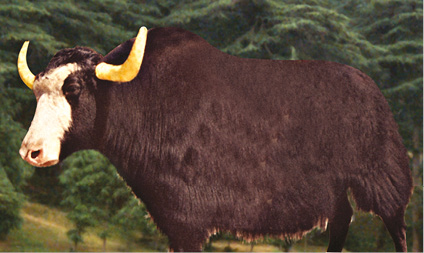
(b)
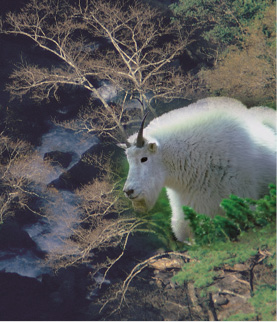
Fig. 9.7 (a) Snow leopard, (b) yak and (c) mountain goat are adapted to mountain habitats
As we go up in the mountainous regions, the surroundings change and we see different kinds of adaptations at different heights.
Grasslands
A lion lives in a forest or a grassland and is a strong animal that can hunt and kill animals like deer. It is light brown in colour. Look at the picture of a lion and that of a deer (Fig. 9.8). How are the eyes placed in the face for these two animals? Are they in the front or on the side of the face? Lions have long claws in their front legs that can be withdrawn inside the toes. Do the features of a lion help it in any way to survive? It’s light brown colour helps it to hide in dry grasslands when it hunts for prey (animals to eat). The eyes in front of the face allow it to have a correct idea about the location of its prey.
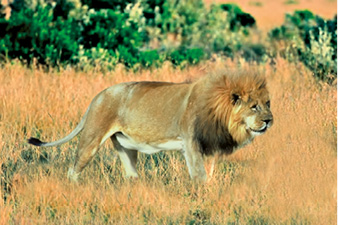
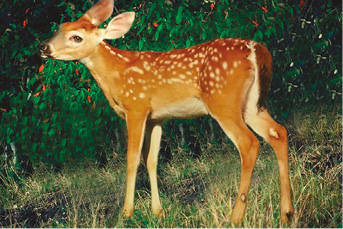
A deer is another animal that lives in forests and grasslands. It has strong teeth for chewing hard plant stems of the forest. A deer needs to know about the presence of predators ( animals like lion that make it their prey ) in order to run away from them and not become their prey. It has long ears to hear movements of predators. The eyes on the side of its head allow it to look in all directions for danger. The speed of the deer helps them to run away from the predators.
There are many other features of a lion, a deer or other animals and plants that help them to survive in their habitat.
Some Aquatic Habitats
Oceans
We already discussed how fish are adapted to live in the sea. Many other sea animals have streamlined bodies to help them move easily in water. There are some sea animals like squids and octopus, which do not have this streamlined shape. They stay deeper in the ocean, near the seabed and catch any prey that moves towards them. However, when they move in water they make their body shapes streamlined. These animals have gills to help them use oxygen dissolved in water.
There are some sea animals like dolphins and whales that do not have gills. They breathe in air through nostrils or blowholes that are located on the upper parts of their heads. This allows them to breathe in air when they swim near the surface of water. They can stay inside the water for a long time without breathing. They come out to the surface from time to time, to breathe in air. Did you ever see this interesting activity of dolphins in television programme or films on ocean life?
Ponds and lakes
Have you seen plants growing in ponds, lakes, rivers and even some drains? Go on a field trip to a nearby pond, if possible, and try to observe the kinds of plants that are seen there. Observe the leaves, stems and roots of these plants.
Some of these plants have their roots fixed in the soil below the water (Fig. 9.9). In terrestrial plants, roots normally play a very important role in the absorption of nutrients and water from the soil. However, in aquatic plants, roots are much reduced in size and their main function is to hold the plant in place.
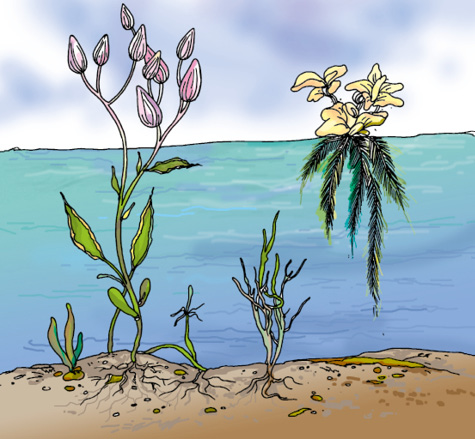
Fig. 9.9 Some aquatic plants float on water. Some have their roots fixed in the soil at the bottom. Some aquatic plants are submerged in water.
The stems of these plants are long, hollow and light. The stems grow up to the surface of water while the leaves and flowers, float on the surface of water.
Some aquatic plants are submerged in water. All parts of such plants are under water. Some of these plants have narrow and thin ribbon-like leaves. These can bend in the flowing water. In some submerged plants, leaves are often highly divided, through which the water can easily flow without damaging them.
Frogs usually live in ponds. Frogs can stay both inside the water as well as move on land. They have strong back legs that help them in leaping and catching their prey. They have webbed feet which help them swim in water.
We have discussed only a few common animals and plants compared to the wide variety that live in different habitats. You may have also noticed the very wide variety in plants around you, when you prepared a herbarium as part of the suggested activities in Chapter 7. Imagine the kind of variety that you could see in a herbarium of leaves of plants from all regions of the Earth!
9.4 Characteristics of Organisms
We went on a journey through different habitats and discussed many plants and animals. In Activity 1, we listed objects, plants and animals found in different surroundings. Suppose we stop a while and think which examples in our list are living? Let us think of examples from a forest. Trees, creepers, small and big animals, birds, snakes, insects, rocks, soil, water, air, dry leaves, dead animals, mushrooms and moss may be only some of the objects that are present in the forest. Which of these are living?
Think of objects that you can see around you at this moment and group them as living and non-living. In some cases, it is easy for us to know. For example, we know that objects like chair or table are not alive. Paheli was reading this rhyme from Complete Nonsense written by Edward Lear:

Paheli and Boojho found the poem very funny, because they knew that a chair or a table is not alive and it cannot talk or walk.
Chair, table, stone or a coin are not alive. Similarly, we do know that we are alive and so are all the people of the world. We also see animals around us that are so full of life — dogs, cats, monkeys, squirrels, insects and many others.
How do we know that something is living? Often, it is not so easy to decide. We are told that plants are living, but they do not move like a dog or a pigeon. On the other hand, a car or a bus can move, still we consider them as non-living. Plants and animals appear to grow in size with time. But then, at times, clouds in the sky also seem to grow in size. Does it mean that clouds are living? No! So, how does one distinguish between living and non-living things? Do living things have some common characteristics that make them very different from the non-living?
You are a wonderful example of a living being. What characteristics do you have which make you different from a non-living thing? List a few of these characteristics in your notebook. Look at your list and mark those characteristics that you have listed, which may also be found in animals or plants.
Some of these characteristics are perhaps common to all living things.
Do all organisms need food?
In Chapters 1 and 2, we learnt that all living things need food and how essential it is to animals and to us. We have also learnt that plants make their own food by the process of photosynthesis. Animals depend on plants or other animals for their food.
Food gives organisms the energy needed for them to grow. Organisms also need energy for other life processes that go on inside them.
Do all organisms show growth?
Does the kurta you had four years back, still fit you? You cannot wear it any more, isn’t it? You must have grown taller during these years. You may not realise it, but you are growing all the time and in few more years you will become an adult. (Fig 9.10).
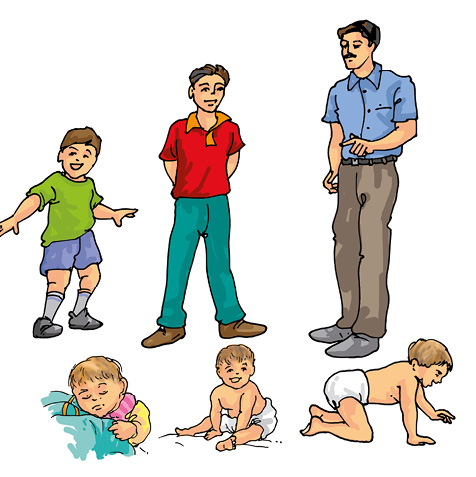
Fig. 9.10 A baby grows into an adult
Young ones of animals also grown into adults. You would surely have noticed pups grow into adults. A chick hatched from an egg, grows into a hen or a cock.(Fig 9.11).
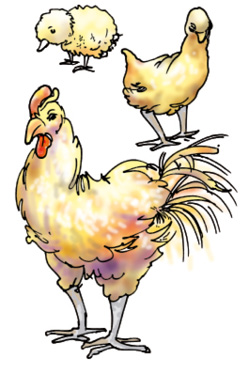
Fig. 9.11 A chicken grows into an adult
Plants also grow. Look around you and see a few plants of a particular type. Some are very small and young, some are bigger. They may all be in different stages of growth. Look at the plants after a few days and weeks. You may find that some of them have grown in size. Growth seems to be common to all living things.
Do you think, non-living things show growth?
Do all organisms respire?
Can we live without breathing? When we inhale, the air moves from outside to the inside of our body. When we breathe out, the air moves from inside our body to outside. Breathing is part of a process called respiration. In respiration, some of the oxygen of the air we breathe in, is used by the body. We breathe out carbon dioxide produced in this process.
The process of breathing in animals like cows, buffaloes, dogs or cats is similar to humans. Observe any one of these animals while they are taking rest, and notice the movement of their abdomen. This slow movement indicates that they are breathing.
Respiration is necessary for all living organisms. It is through respiration that the body finally obtains energy from the food it takes.
Some animals may have different mechanisms for the exchange of gases, which is a part of the respiration process. For example, earthworms breathe through their skin. Fish, we have learnt, have gills for using oxygen dissolved in water. The gills absorb oxygen from the air dissolved in water.
Do plants also respire? Exchange of gases in plants mainly takes place through leaves. The leaves take in air through tiny pores in them and use the oxygen. They give out carbon dioxide to the air.
We learnt that in sunlight, plants use carbon dioxide to produce food and give out oxygen. The amount of oxygen released in the process of food preparation by plants is much more than the oxygen they use in respiration. Respiration in plants takes place day and night.
Do all organisms respond to stimuli?
How do you respond, if you suddenly step on a sharp object like a thorn, while walking barefoot? How do you feel when you see or think about your favourite food? You suddenly move from a dark place into bright sunlight. What happens? Your eyes shut themselves automatically for a moment till they adjust to the changed bright surroundings. Your favourite food, bright light and a thorn, in the above situations are some examples of changes in your surroundings. All of us respond immediately to such changes. Changes in our surroundings that makes us respond to them, are called stimuli.
Do other animals also respond to stimuli? Observe the behaviour of animals, when food is served to them. Do you find them suddenly becoming active on seeing the food? When you move towards a bird, what does it do? Wild animals run away when bright light is flashed towards them. Similarly, cockroaches begin to move to their hiding places if the light in the kitchen is switched on at night. Can you give some more examples of responses of animals to stimuli?
Do plants also respond to stimuli? Flowers of some plants bloom only at night. In some plants flowers close after sunset. In some plants like Mimosa, commonly known as ‘touch-me-not’, leaves close or fold when someone touches them. These are some examples of responses of plants towards changes in their surroundings.
Activity 4
Place a potted plant in a room a little away from a window through which sunlight enters some time during the day (Fig. 9.12). Continue watering the plant for a few days. Does the plant grow upright, like plants out in the open? Note the direction in which it bends, if it is not growing upright. Do you think, this may be in response to some stimulus?
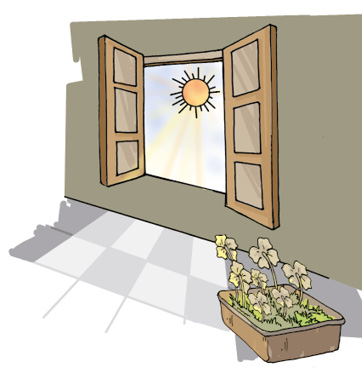
Fig. 9.12 Plant respond to light
All living things respond to changes around them.
Living organisms and excretion
All organisms need food. Not all the food that is eaten is completely used, only a part of it is utilised by the body. What happens to the rest? This has to be removed from the body as wastes. Our body produces some wastes in other life processes also. The process of getting rid of wastes by organisms is known as excretion.
Do plants also excrete? They do, but not as seen in animals. The mechanisms in plants are a little different. Some plants find it possible to store the waste products within their parts in a way that they do not harm the plant as a whole. Some plants remove waste products as secretions.
Excretion is another characteristic common to all organisms.
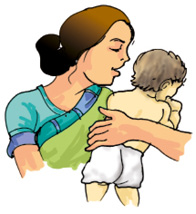
Do all organisms reproduce their own kind?
Have you ever seen nests of some birds like pigeons? Many birds lay their eggs in the nest. Some of the eggs hatch and young birds come out of them(Fig. 9.13).
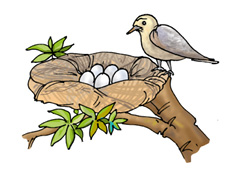
(a)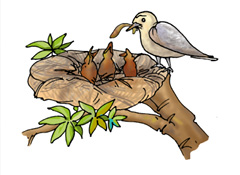
(b)
Fig. 9.13 (a) Birds lay eggs which after hatching produce (b) young ones
Animals reproduce their own kind. The mode of reproduction may be different, in different animals. Some animals produce their young ones through eggs. Some animals give birth to the young ones (Fig. 9.14).

Fig. 9.14 Some animals which give birth to their young ones
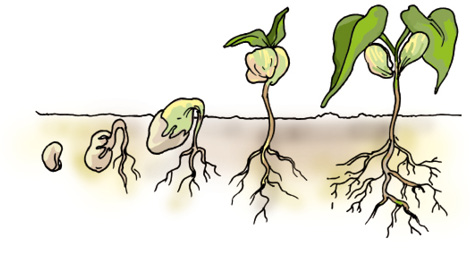
Some plants also reproduce through parts other than seeds. For example, a part of a potato with a bud, grows into a new plant (Fig 9.16).
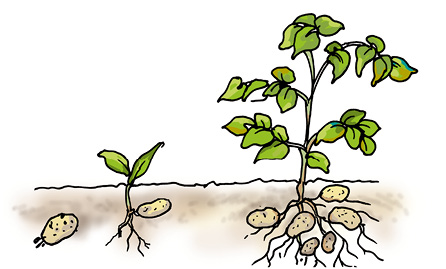
Fig. 9.16 A new plant grows from a bud of potato
Plants also reproduce through cuttings. Would you like to grow a plant in this way yourself?
Activity 5
Take a cutting from a rose or a menhdi plant. Fix it in the soil and water it regularly. What do you observe, after a few days?
It may not be easy to grow plants from cuttings. Do not be disappointed if your cutting does not grow. Talk to a gardener, if possible, on the care to be given to cuttings to make them grow into plants.
Living things produce more of their own kind through reproduction. It takes place in many different ways, for different organisms.
Do all organisms move?
In Chapter 8, we discussed the various ways in which animals move. They move from one place to another and also show other body movements.
What about plants? Do they also move? Plants are generally anchored in soil so they do not move from one place to another. However, various substances like water, minerals and the food synthesised by them move from one part of the plant to other. Have you noticed any other kind of movement in plants? Opening or closing of flowers? Do you recall how some plants show movement in response to certain stimuli?
We also have some non-living things moving, of course. A bus, car, a small piece of paper, clouds and so on. Is there something different in these movements from the movements of living beings?
There is such a variety of living organisms, but, all of them show some common characteristics, as we have discussed. Yet another common characteristic is that living beings die. Because organisms die, particular types of organisms can survive over thousands of years only if they reproduce their own kind. One single organism may die without ever reproducing, but, the type of organism can exist only if there is reproduction.
We see that, all living things seem to have some common characteristics. They all need food, respire, respond to stimuli, reproduce, show movement, grow and die.
Do we find some non-living things that also show some of these characteristics? Cars, bicycle, clocks and the water in the river move. The moon moves in the sky. A cloud grows in size right in front of our eyes. Can such things be called living? We ask ourselves, do these objects also show all the other characteristics of living things?
In general, something that is living may have all the characteristics that we have discussed, while non-living things may not show all these characteristics at the same time.
Is this always true? Do we always find that living things definitely show all the characteristics of the living that we have discussed? Do we always find that non-living things may show only some of these characteristics and never all of them?
To understand this a little better, let us look at a specific example. Consider any seed, say,moong. Is it living? It can stay in a shop for months and not show any growth or some of the other characteristics of life. However, we bring the same seed and plant it in soil, water it and it turns into a whole plant. Did the seed — need food, did it excrete, grow or reproduce when it was in the shop for many months?
We see that there can be cases when we cannot easily say that a thing has all the characteristics that we have discussed, for it to be called living.
What then is life?”
Push your hand deep inside a sack of wheat. Do you find it is warm inside? There is some heat being produced inside the sack of wheat. The seeds respire and in that process give out some heat.
We see that respiration is a process that takes place in seeds even when some of the other life processes may not be very active.
It may not be very easy to answer our question — “what then is life”? However, looking at all the diversity of living beings around us, we can conclude that “life is beautiful”!
KeyWords
Adaptation
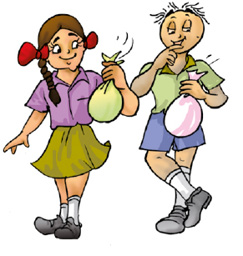
Aquatic habitat
Biotic component
Excretion
Growth
Habitat
Living
Reproduction
Respiration
Stimulus
Summary
- The surroundings where plants and animals live, is called their habitat.
- Several kinds of plants and animals may share the same habitat.
- The presence of specific features and habits, which enable a plant or an animal to live in a particular habitat, is called adaptation.
- There are many types of habitats, however, these may be broadly grouped as terrestrial (on the land) and aquatic (in water).
- There is a wide variety of organisms present in different habitats.
- Plants, animals and microorganisms together constitute biotic components.
- Rocks, soil, air, water, light and temperature are some of the abiotic components of our surroundings.
- Living things have certain common characteristics — they need food, they respire and, excrete, respond to their environment, reproduce, grow and show movement.
Exercises
1. What is a habitat?
2. How are cactus adapted to survive in a desert?
3. Fill up the blanks
(a) The presence of specific features, which enable a plant or an animal to live in a particular habitat, is called .
(b) The habitats of the plants and animals that live on land are called
habitat.
(c) The habitats of plants and animals that live in water are called
habitat.
(d) Soil, water and air are the ———— factors of a habitat.
(e) Changes in our surroundings that make us respond to them, are
called .
4. Which of the things in the following list are nonliving?
Plough, Mushroom, Sewing machine, Radio, Boat, Water hyacinth, Earthworm
5. Give an example of a non-living thing, which shows any two characteristics of living things.
6. Which of the non-living things listed below, were once part of a living thing?
Butter, Leather, Soil, Wool, Electric bulb, Cooking oil, Salt, Apple, Rubber
7. List the commoncharacteristics of the living things.
8. Explain, why speed is important for survival in the grasslands for animals
that live there. (Hint: There are few trees or places for animals to hide in grasslands habitats.)
suggested Projects and Activities
1. Many magazines and newspapers talk about possibility of life outside the Earth. Read these articles and have a discussion in the class about what could be defined as life outside Earth.
2. Visit a local zoo and find out what special arrangements are made for the animals that have been brought there from different habitats.
3. Find out where are the habitats of the polar bear and the penguin. For each animal, explain two ways in which it is well adapted to its habitat.
4. Find out which animals live in the foot-hills of the Himalayas. Find out if the types and varieties of animals and plants changes as one goes higher into the mountain regions of the Himalayas.
5. Make a habitat album. Try to obtain pictures of animals and plants that you have listed in Activity 1 and paste these under different habitat sections in the album. Draw the leaf shapes and structures for trees found in these different regions and include these in the album. In addition, draw the patterns of branching found in trees of these different regions and include these also in the album.

